Rooted in Skill: The Art and Effort of Tree Work and Arboriculture
Tree work goes far beyond simply cutting branches and felling trees—it’s a combination of science, skill, and sustainability. Every tree presents unique challenges, from assessing its health to safely managing its removal, especially in tight spaces or near structures. As an arborist, it’s not just about getting the job done, but doing it with an eye toward long-term environmental stewardship. That’s why integrating sustainable practices like hugelbeds into tree work is so important, offering an alternative to chipping or burning waste and creating lasting benefits for the land.
Assessing Tree Health: Understanding When to Act
The first step in responsible arboriculture is understanding the health of the trees you’re working with. Not every leaning or damaged tree needs to come down—sometimes proper pruning, soil care, or even bracing can give a tree a longer life. Assessing a tree’s health means looking at more than just visible damage. It involves examining root structure, identifying disease or pests, and checking for internal decay through sounding or core sampling.
When a tree truly becomes a hazard—posing a risk to nearby buildings or people—removal becomes necessary. But every tree decision starts with understanding its role in the landscape, its condition, and whether intervention can prevent removal.
Felling Trees Safely in Difficult Situations
Some trees are easy to bring down, but others—whether leaning toward a house, tangled with power lines, or located on a slope—require precise planning. Safety is paramount, so using proper rigging and directional felling techniques ensures the tree comes down exactly where intended. In particularly tricky situations, climbing the tree and dismantling it in sections is often the safest approach.
Each tree presents unique challenges, but knowing how to use tools like ropes, pulleys, and wedges correctly makes the difference between a smooth operation and a dangerous one. Tree work demands respect for both the tree itself and the environment around it—leaving as little disturbance as possible.
Using Hugelbeds to Benefit the Land
Instead of simply chipping branches and grinding stumps, we’ve found that using hugelbeds offers a much better way to handle tree debris. A hugelbed, or hügelkultur, involves stacking logs, branches, and organic material into mounds that act as long-term water reservoirs. Over time, the wood breaks down, creating rich soil while retaining moisture—turning what would be waste into a resource.
Hugelbeds are especially useful on land that suffers from water runoff or erosion. The mounds absorb rainfall like sponges, slowly releasing moisture back into the surrounding area and creating a more self-sustaining ecosystem. This approach not only reduces the need for irrigation but also helps the land heal.
Creating a Carbon Sink: Avoiding the Burn Pile
In traditional tree work, slash—branches, brush, and smaller debris—often gets burned to clear the site. While burning might seem like an easy solution, it releases all the stored carbon in the wood directly into the atmosphere. A more sustainable approach is to keep that carbon sequestered by turning the waste into hugelbeds or even leaving some fallen material on the ground as habitat for insects and fungi.
This way, the wood slowly decomposes and enriches the soil while keeping carbon locked into the landscape. Avoiding unnecessary burning helps reduce our carbon footprint and contributes to healthier ecosystems—turning tree waste into an asset instead of pollution.
All roped in and
ready to rip!
Balancing Arborist Work with Sustainability
Tree work isn’t just about chainsaws and ropes—it’s about understanding trees as living systems within a larger environment. Whether assessing tree health, felling trees safely in difficult locations, or using hugelbeds to regenerate the landscape, every step we take as arborists impacts the land for years to come.
By focusing on sustainable practices, we ensure that even when trees need to be removed, they continue to benefit the environment. Tree work rooted in skill and sustainability transforms what could have been a loss into an opportunity—for healthier landscapes, richer soil, and a future with more resilient ecosystems.





